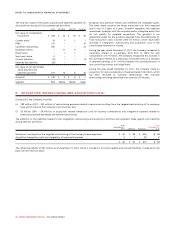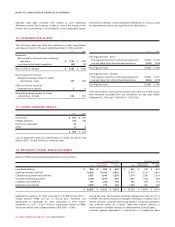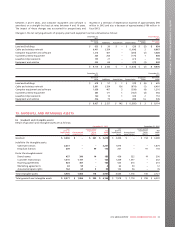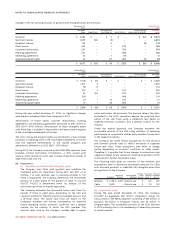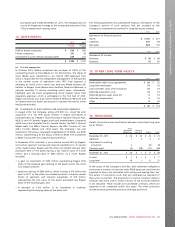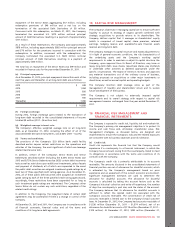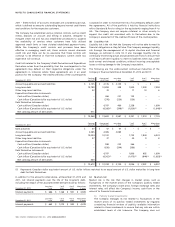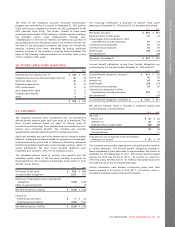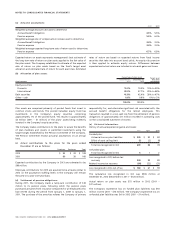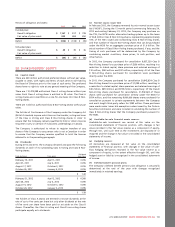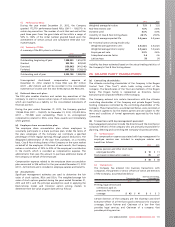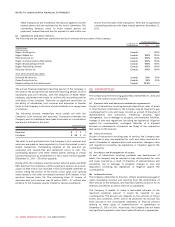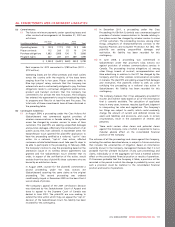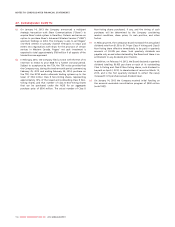Rogers 2012 Annual Report Download - page 109
Download and view the complete annual report
Please find page 109 of the 2012 Rogers annual report below. You can navigate through the pages in the report by either clicking on the pages listed below, or by using the keyword search tool below to find specific information within the annual report.
NOTES TO CONSOLIDATED FINANCIAL STATEMENTS
routinely engage in risk management practices such as hedging,
derivatives or short selling with respect to its publicly traded
investments.
At December 31, 2012, a $1 change in the market price per share
of the Company’s publicly traded investments would have
resulted in a $14 million change in the Company’s other
comprehensive income, net of income taxes of $2 million.
(ii) Stock-based compensation:
The liability related to stock-based compensation is marked-to-
market each period, and stock based compensation expense is
impacted by the change in the price of the Company’s Class B
Non-Voting shares during the life of an award, including SARs,
RSUs and DSUs.
At December 31, 2012, a $1 change in the market price of the
Company’s Class B Non-Voting shares would have resulted in a
change of $6 million in net income.
The Company may use derivatives from time to time to manage
its exposure to fluctuations with its stock-based compensation
expense.
(iii) Foreign exchange and interest rates:
The Company uses derivative financial instruments to manage its
risks from fluctuations in foreign exchange and interest rates
associated with its U.S. dollar denominated debt instruments. All
such agreements are used for risk management purposes only
and are designated as hedges of specific debt instruments for
economic purposes. The Company also uses derivative financial
instruments to manage the foreign exchange risk in its
operations. All such agreements are used for risk management
purposes only, and, in certain cases, are designated as hedges for
certain of the Company’s operational expenditures. The
Company does not use derivative instruments for speculative
purposes. From time to time, these derivative financial
instruments include cross-currency interest rate exchange
agreements, foreign exchange forward contracts and foreign
exchange option agreements.
At December 31, 2012, all of the Company’s long-term debt was
at fixed interest rates excluding the credit facility.
U.S. $350 million of the Company’s U.S. dollar-denominated
long-term debt instruments are not hedged for accounting
purposes and, therefore, a one cent change in the Canadian
dollar relative to the U.S. dollar would have resulted in a
$4 million change in the carrying value of long-term debt at
December 31, 2012. In addition, this would have resulted in a
$3 million change in net income, net of income taxes of
$1 million. There would have been a similar, offsetting change in
the carrying value of the associated U.S. $350 million of Debt
Derivatives with a similar offsetting impact on net income.
In July 2011, the Company entered into foreign exchange
forward contracts to manage foreign exchange risk on certain
forecasted expenditures. All of these Expenditure Derivatives
were accounted for as hedges during the year ended
December 31, 2012, with changes in fair value being recorded in
the hedging reserve, a component of equity. The Expenditure
Derivatives fix the exchange rate on an aggregate U.S. $20
million per month of the Company’s forecast expenditures at an
average exchange rate of C$0.9643/U.S.$1 from August 2011
through July 2014. At December 31, 2012, U.S. $380 million of
these Expenditure Derivatives remain outstanding.
A portion of the Company’s accounts receivable and accounts
payable and accrued liabilities is denominated in U.S. dollars;
however, due to their short-term nature, there is no significant
market risk arising from fluctuations in foreign exchange rates.
(d) Derivative instruments:
At December 31, 2012, 91.7% of the Company’s U.S. dollar-
denominated long-term debt instruments were hedged against
fluctuations in foreign exchange rates for accounting purposes. At
December 31, 2012, details of the Derivatives net liability position are
as follows:
December 31, 2012 U.S. $
notional Exchange
rate Cdn. $
notional Fair
value
Debt Derivatives accounted
for as cash flow hedges:
As assets $ 1,600 1.0252 $ 1,640 $ 34
As liabilities 2,280 1.2270 2,798 (561)
Debt Derivatives not
accounted for as hedges:
As assets 350 1.0258 359 3
Net mark-to-market liability
Debt Derivatives (524)
Expenditure Derivatives
accounted for as cash flow
hedges:
As assets 380 0.9643 366 13
Net mark-to-market liability $ (511)
The net mark-to-market derivative liability of the Derivatives is
comprised of:
2012 2011
Current asset $8$16
Long-term asset 42 64
50 80
Current liability (144) (37)
Long-term liability (417) (503)
(561) (540)
Net mark-to-market liability $ (511) $ (460)
In 2012, a $4 million decrease in estimated fair value (2011 – $6
million increase) related to hedge ineffectiveness was recognized in
net income.
2012 ANNUAL REPORT ROGERS COMMUNICATIONS INC. 105



